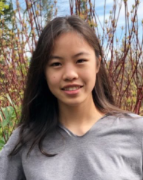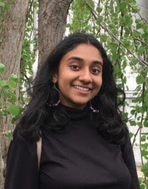By Katherine Huang, Founder and Executive Director
When I was eleven, I was obsessed with Percy Jackson, a book series about the adventures of a teenage demigod. While watching the movie, I thought Apollo was pretty good-looking, and ended up on a video montage of Greek male models. What captured my attention, though, was the Greek song in the background.

Looking up a translation didn’t feel like enough — instead, the lyrics became a puzzle I was determined to solve. Although three years of poring over Greek news articles and chatting with natives online didn’t make me fluent, I realized that when you understand another language, another world opens up to you.
At the time, I was also obsessed with Tumblr, home to communities of bloggers who shared my interests, from Percy Jackson to languages. I wanted to express myself with a custom blog design, so I pored over thousands of lines of HTML, CSS, and JavaScript code from existing themes until I could write my own. When I understood these languages, another world opened up to me.
During high school, I explored science. I analyzed potential antidotes against botulinum neurotoxin (the “most poisonous poison” and the active ingredient in Botox). I built models to classify DNA sequences as protein-coding or noncoding, a crucial step in understanding our genome. At science fairs, in the span of a few minutes, I might explain my bioinformatics research to a curious electrical engineer, to a five-year-old, and to a scientist who works with the developer of the software I used.
It’s demanding, but there’s nothing like the moment when a grin of understanding lights up the kid’s eyes, or when the engineer, who’s forgotten most of high school biology, has an “aha!” moment. It clicks, and I can see another world opening up to them. I’ve realized that it isn’t enough to explain science only to scientists.
Not everyone needs to be a scientist, but science impacts all of us. Understanding it is crucial to making informed decisions about the things we care about, and that means we need a better bridge between science… and us. Yet while there are thousands of activities helping people my age learn STEM, there’s nothing to help young people communicate it. So last year, at seventeen, I started Science and Us. Read on to learn about the impact we’re making.
By Parin Shaik, Leadership Team Member

Last June, I attended the first Science and Us event. Well, my parents signed eighth-grade me up for this high school event. I sat in the car for 45 minutes on a Saturday morning, sweating and wondering, “Why am I going to an event that’s probably about writing lab reports?” I spend most of my time rehearsing in the auditorium and in theatre classes, not studying science.
Though it seemed like my parents had carved out three boxes for my future — doctor, engineer, or lawyer — I’ve never been drawn to anatomy or the way robots function. Instead, I’m drawn to the characters of graphic novels and anime, especially my favorite: Sailor Moon. My notebook margins are safe havens for characters I obsess over and sketch to life (which may have taken a toll on my biology grade).
During the first presentation at Science and Us, that’s exactly what I was doing: drawing in the free notebooks we got. Then, we moved into a workshop room, and the speaker pulled up — of all things — her Twitter page! Finally, someone speaking my language. In all the hours I’d spent scrolling through Twitter, I never realized you could use it to communicate science.
For once, my hands jotted down notes instead of doodles. I began actually caring about the event and scicomm mediums, such as podcasting and tweeting. By the end of the day, when the organizers announced that they were recruiting for their team, I immediately applied and became an organizer. After being accepted, the once-introverted me began speaking up in weekly conference calls and emailing scary adults. However, I wasn’t always confident I was mature enough to fulfill the responsibilities.
Whenever that happened, I remembered that Science and Us had opened up a new world for me: a world in which Sailor Moon and photosynthesis could coexist. I wanted to make that change in others’ lives too, so I persisted. Although I still haven’t figured out how to end calls non-awkwardly, I can say that Science and Us has changed not only how I think about science, but also me as a person. I have learned to embrace my diverse interests and expand my horizon of careers: currently, I am considering working in the neuroscience field and perhaps conveying research through art.
Note from Katherine Huang: Science and Us is a team of high schoolers spreading the knowledge that changed our lives. When we help teens communicate STEM topics, we’re empowering them to approach complex issues and solve difficult problems.
We open up opportunities for youth to fuse their diverse interests into fulfilling careers. Interdisciplinary fields like science media, policy, and outreach are essential, yet rarely mentioned in schools.
Parin and I are lucky to have discovered those opportunities, but finding a place for STEM in your life shouldn’t come down to luck. So this summer, we’re writing Stories of Science and Us, featuring journeys and advice from a diverse group of people who connect STEM and the public.
You can get involved by supporting our Indiegogo campaign at igg.me/at/scienceandus. If you’re an educator or student, we’d love to know how we can make Stories a valuable resource for you—let us know what you want to see in the book at scienceandus.org/stories. If you’d like to be interviewed or have other questions, reach out to contact@scienceandus.org. We hope to hear from you!



Leave a Reply